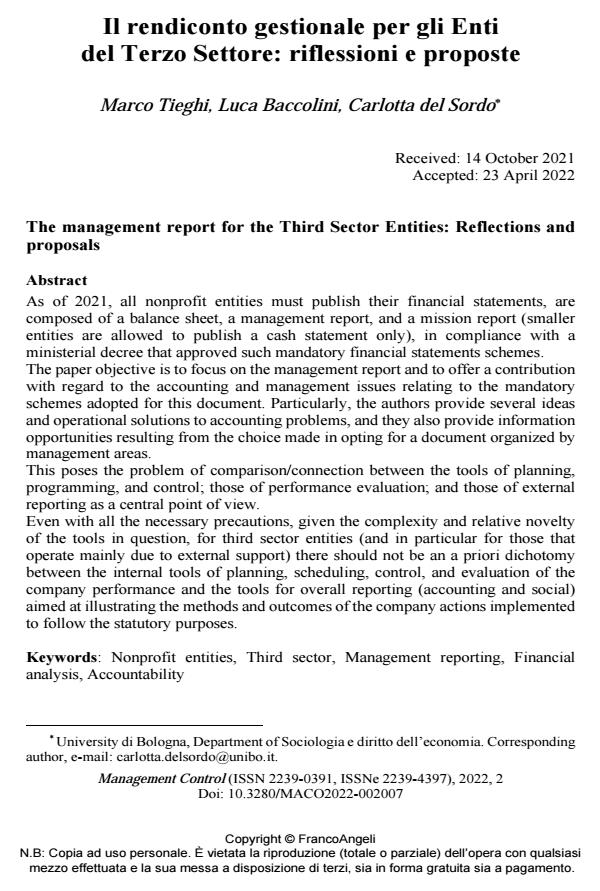The management report for the Third Sector Entities: Reflections and proposals
Journal title MANAGEMENT CONTROL
Author/s Marco Tieghi, Luca Baccolini, Carlotta del Sordo
Publishing Year 2022 Issue 2022/2
Language Italian Pages 23 P. 141-163 File size 303 KB
DOI 10.3280/MACO2022-002007
DOI is like a bar code for intellectual property: to have more infomation
click here
Below, you can see the article first page
If you want to buy this article in PDF format, you can do it, following the instructions to buy download credits

FrancoAngeli is member of Publishers International Linking Association, Inc (PILA), a not-for-profit association which run the CrossRef service enabling links to and from online scholarly content.
As of 2021, all nonprofit entities must publish their financial statements, are composed of a balance sheet, a management report, and a mission report (smaller entities are allowed to publish a cash statement only), in compliance with a ministerial decree that approved such mandatory financial statements schemes. The paper objective is to focus on the management report and to offer a contribution with regard to the accounting and management issues relating to the mandatory schemes adopted for this document. Particularly, the authors provide several ideas and operational solutions to accounting problems, and they also provide information opportunities resulting from the choice made in opting for a document organized by management areas. This poses the problem of comparison/connection between the tools of planning, programming, and control; those of performance evaluation; and those of external reporting as a central point of view. Even with all the necessary precautions, given the complexity and relative novelty of the tools in question, for third sector entities (and in particular for those that operate mainly due to external support) there should not be an a priori dichotomy between the internal tools of planning, scheduling, control, and evaluation of the company performance and the tools for overall reporting (accounting and social) aimed at illustrating the methods and outcomes of the company actions implemented to follow the statutory purposes.
Keywords: Nonprofit entities, Third sector, Management reporting, Financial analysis, Accountability
- La rilevanza dei componenti economici figurativi per gli Enti del Terzo Settore: riflessioni e proposte Marco Tieghi, Carlotta del Sordo, in WELFARE E ERGONOMIA 2/2023 pp.13
DOI: 10.3280/WE2022-002002
Marco Tieghi, Luca Baccolini, Carlotta del Sordo, Il rendiconto gestionale per gli Enti del Terzo Settore: riflessioni e proposte in "MANAGEMENT CONTROL" 2/2022, pp 141-163, DOI: 10.3280/MACO2022-002007